计算机通信与网络 课程资料 (5)
通信与网络技术的培训资料

更多应用场景
6G网络将支持更多新兴应用场景, 如自动驾驶、远程医疗和智能制造等 。
04 互联网协议栈与TCP/IP 原理剖析
OSI七层模型简介
物理层
负责传输比特流,规定了接口标准、电气特性等 。
数据链路层
将比特流组合成数据帧,进行差错控制和流量控 制。
网络层
负责数据包的路由和转发,实现不同网络之间的 通信。
SSL VPN
利用SSL协议构建安全通道,无需安装客户 端软件即可实现远程访问。
MPLS VPN
基于MPLS技术构建虚拟专用网络,提供高 质量的网络服务和安全性保障。
网络性能优化策略部署
带宽管理
合理分配网络带宽资源,确保关键业务应用 的带宽需求得到满足。
内容分发网络(CDN)
利用缓存技术将内容分发到离用户最近的节 点上,提高用户访问速度和体验。
物联网在无线通信中应用前景
智能家居
通过无线通信技术实现家居设备的互联互通和智能化控制。
智能交通
利用物联网技术实现车辆之间的信息交互和协同驾驶,提高交通 安全性和效率。
工业自动化
物联网技术可实现设备的远程监控和维护,提高生产效率和降低 成本。
卫星通信基本原理和应用领域
基本原理
利用人造地球卫星作为中继站转发无线电信号,实现两个或多个地球站之间的 通信。
制冷与通风
数据中心应采用合理的制冷和通风方案,确保服 务器等设备在适宜的温度和湿度环境下运行。同 时,应考虑节能环保因素,采用高效节能的制冷 设备和通风系统。
供电与配电
数据中心应采用双路供电或更高级别的供电方案 ,保证电力供应的稳定性和可靠性。同时,应配 备UPS不间断电源、发电机等备用电源设备,以 应对电力故障等突发情况。
计算机通信与网络 课程资料 Computer Communications and Networking
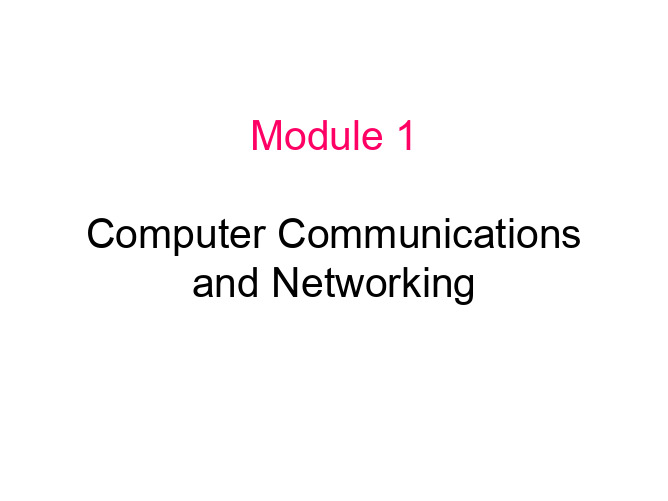
CCN: Lecture Notes
Computer Comm. & Networking 13
Transport Layer
This layer ensures that data units are delivered error free, in sequence, with no losses or duplications.
Module 1
Computer Communications and Networking
Topic Covered
1. 7 layer model for computer communications 2. Network topologies 3. Network bearers 4. LANs and WANs 5. CSMA and token protocols 6. Networking protocol performance 7. Bridges and routing 8. Internet protocols 9. Network security
• Compatibility must be maintained
CCN: Lecture NotNetworking 3
How do we do all of this?
Consider a simple connection between computers
This layer also provides • Interaction management, i.e., full or half duplex • Synchronisation, i.e., inset synchronisation points and
计算机网络和通信基础知识

本
章
要
点本课主要讲解计算机网络的形成与发展,定义、功能和分类以及
图1-1
公用电话网
M T
M
M T
FEP
计算机 M
M
M T
FEP —— 前端处理机 M —— 调制解调器 T —— 终端
用前端处理机完成通信任务
图1-2
年代初期,美国航空公司投入使用的飞机票预定系统就是一种面向终端的远程联机系统,这个系统名为SABRE,即Semi-Automatic Business Research Environment,由一台计算机和遍布全美国的2000多个终端组成。
2.数据通信网络
第二代计算机网络以美国的ARPA网(ARPANet)为典型代表。
ARPA网是世界上第一个
图1-3
可以看出,ARPA网分成两个部分:通信子网和资源子网。
其中,通信子网主
客户机、服务器
图1-5
另一种计算机网络的形式是基于客户/服务器(Client/Server,C/S)模式的。
其中,服务器是指网络上管理共享资源的计算机。
通常,客户机是网络中请求其他计算机(如服务器)上的
服务器
客户机
图1-6
7
图1-7
双绞线(Twisted Pairwire)分为两种:屏蔽双绞线(Shielded Twisted Pair,STP)和非屏
图1-8 图1-9
2.同轴电缆
内层导线
绝缘体
金属屏蔽
外绝缘层 图1-10 图1-11 3.光纤(光缆)
图1-12。
计算机通信网络
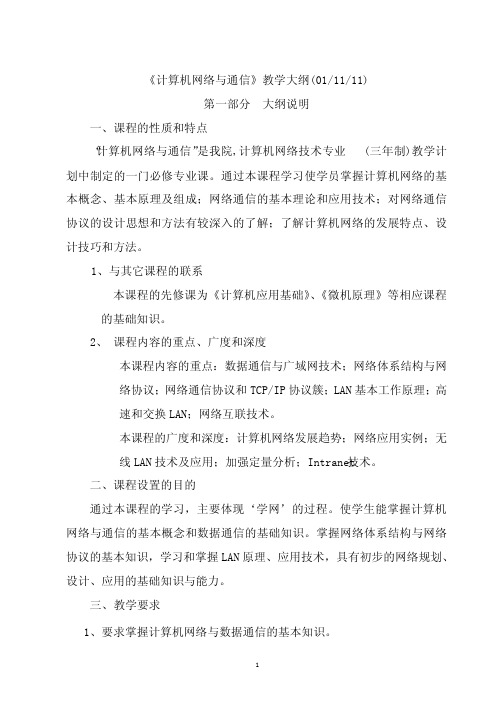
《计算机网络与通信》教学大纲(01/11/11)第一部分 大纲说明一、课程的性质和特点“计算机网络与通信”是我院‚计算机网络技术专业‛(三年制)教学计划中制定的一门必修专业课。
通过本课程学习使学员掌握计算机网络的基本概念、基本原理及组成;网络通信的基本理论和应用技术;对网络通信协议的设计思想和方法有较深入的了解;了解计算机网络的发展特点、设计技巧和方法。
1、与其它课程的联系本课程的先修课为《计算机应用基础》、《微机原理》等相应课程的基础知识。
2、 课程内容的重点、广度和深度本课程内容的重点:数据通信与广域网技术;网络体系结构与网络协议;网络通信协议和TCP/IP协议簇;LAN基本工作原理;高速和交换LAN;网络互联技术。
本课程的广度和深度:计算机网络发展趋势;网络应用实例;无线LAN技术及应用;加强定量分析;Intranet技术。
二、课程设置的目的通过本课程的学习,主要体现‘学网’的过程。
使学生能掌握计算机网络与通信的基本概念和数据通信的基础知识。
掌握网络体系结构与网络协议的基本知识,学习和掌握LAN原理、应用技术,具有初步的网络规划、设计、应用的基础知识与能力。
三、教学要求1、要求掌握计算机网络与数据通信的基本知识。
2、准确理解网络体系结构、网络协议的基本内容。
3、熟悉通信子网、局域网、以太网、万维网的技术特点。
4、掌握网络互连技术技术5、熟悉Internet/Intranet6、了解网络管理的知识和技术。
第二部分 教学内容第一章 计算机网络概论1.1 计算机网络的形成与发展。
1.1.1计算机网络发展阶段的划分1.1.2计算机网络的形成1.1.3ARPANET与分组交换技术1.1.4网络体系结构与协议标准化的研究的应用与高速网络技术的发展1.1.5Internet1.2计算机网络的定义1.2.1计算机网络定义的基本内容1.2.2计算机网络与分布式系统的区别1.3计算机网络的分类1.3.1根据网络传输技术进行分类1.3.2根据网络的覆盖范围进行分类1.4计算机网络拓朴构型1.4.1计算机网络拓朴的定义1.4.2网络拓朴分类方法1.5典型计算机网络1.5.1ARPANET1.5.2NSFNET1.5.3Internet1.6数据通信服务1.6.1未来通信子网应具备的特征1.6.2交换多兆位数据服务SMDS1.6.3X.25网1.6.4帧中继1.6.5B-ISDN1.6.6异步传输模式ATM1.7计算机网络的应用1.7.1计算机网络在企业、机关信息管理与信息服务中的应用1.7.2计算机网络在个人信息服务中的应用1.8 计算机网络的应用带来的社会问题第二章 数据通信技术与广域网技术2.1 数据通信的基本概念2.1.1 信息、数据和信号2.1.2 数据传输类型与通信方式2.2 传输介质及主要特性2.2.1 传输介质的主要特性2.2.2 双绞线的主要特性2.2.3 同轴电缆的主要特性2.2.4 光缆的主要特性2.3 无线与卫星通信2.3.1 电磁波谱与移动通信2.3.2 无线通信2.3.3 微波通信2.3.4 蜂窝无线通信2.3.5 卫星通信2.4 数据编码技术2.4.1 数据编码类型2.4.2 模拟数据编码方法2.4.3 数字数据编码方法2.4.4 脉冲编码调制方法2.5 基带传输2.5.1 基带传输的定义2.5.2 通信信道带宽对基带传输的影响2.5.3 数据传输速率的定义与信道速率的极限 2.6 频带传输2.6.1 频带传输的定义2.6.2 调制解调器的基本工作原理2.6.3 调制解调器的分类与标准2.6.4 调制速率与数据传输速率2.7 多路复用技术2.7.1 多路复用技术的分类2.7.2 频分多路复用FDM2.7.3 波分多路复用WDM2.7.4 时分多路复用TDM2.8 广域网中的数据交换技术2.8.1 线路交换方式2.8.2 存储转发交换方式2.8.3 数据报方式2.8.4 虚电路方式2.8.5 ATM方式2.9 差错控制方法2.9.1 差错产生的原因与差错类型2.9.2 误码率的定义2.9.3 检错码与纠错码2.9.4 循环冗余编码工作原理2.9.5 差错控制机制第三章 网络体系结构与网络协议3.1 网络体系结构的基本概念3.2 ISO/OSI 参考模型3.2.1 OSI参考模型的基本概念3.2.2 OSI 参考模型的结构与各层的主要功能3.3 TCP/IP参考模型与协议3.3.1 TCP/IP参考模型与协议的发展过程3.3.2 TCP/IP参考模型与层次3.3.3 IP协议3.3.4 TCP协议3.3.5 OSI参考模型与TCP/IP参考模型的比较3.4 IEEE802 LAN体系结构3.4.1IEEE802标准3.4.2 IEEE802参考模型(HDLC)第四章 局域网技术4.1 LAN的要技术特点4.2 LAN介质访问控制方法分类4.2.1 Ethernet基本工作原理4.2.2 IEEE802.4标准与Token Bus4.2.3 IEEE802.5标准与Token Ring4.2.4 CSMA/CD与Token Bus、Token Ring比较 4.3 高速LAN4.3.1 高速LAN研究基本方法4.3.2 光纤分布式数据接口FDDI4.3.3 快速以太网Fast Ethernet4.3.4 千兆位以太网Gigabit Ethernet4.4 交换LAN4.4.1 交换LAN的基本结构4.4.2 LAN交换机的工作原理4.5 LAN组网方法4.5.1 I EEE802.3 物理层标准类型4.5.2 Ethernet 网络接口适配器4.5.3 同轴电缆Ethernet 组网方法4.5.4 符合100BASE-T标准的Ethernet组网方法4.5.5 千兆Ethernet网组网方法第五章 网络操作系统5.1 网络操作系统的基本概念5.2 典型网络操作系统简介第六章 网络互连技术6.1 络互连的基本概念6.2 网络互连的类型6.3 网络互连的层次6.4 网络互连的要求6.5 网络互连的设备6.5.1 网桥Bridge6.5.2 路由器Router6.5.3 网关 Gateway第七章 Internet基础与应用7.1 主机名字与域名服务7.2 域名与域名系统7.3 Internet 的基本服务功能7.3.1 E-mail服务7.3.2 Telnet服务7.3.3 文件传输服务7.3.4 WWW服务7.3.5 新闻与公告类服务7.4 Intranet技术7.4.1 企业网技术的发展7.4.2 Intranet 定义7.4.3 Intranet的主要技术特点7.4.4 Intranet的结构与开发方法第8章 网络管理技术8.1 网络管理的基本概念8.2 Internet网络管理模型8.3 OSI管理功能域8.4 简单网络管理协议SNMP8.5 典型的网络管理软件[实验内容]实验一、对等网络连接与管理实验二、物理层实验实验三、数据链路层说 明:实验目的:是巩固讲课内容和实践锻炼。
计算机网络与通信复习资料完整版

《计算机网络与通信》复习资料课后习题答案选择题第一章1、局域网与广域网的互联是通过(B)来实现的。
A: 通信子网B、路由器 C、城域网 D、电话交换网2、计算机网络是计算机技术与(C)技术密切结合的产物A:交换机 B、硬件C、通信 D、自动控制3、20世纪60年代,美国国防部高级研究中心提出的网络研究课题的名称为(D)A、WANB、LANC、TCP/IPD、ARPAnet第二章1、波特率等于(B)A、每秒传输的比特数B、每秒传输的周期数C、每秒传输的脉冲数D、每秒传输的字节数2、在传输介质中,带宽最大、信号衰减最小、抗干扰能力最强的是(B )A、双绞线B、光纤C、同轴电缆D、无线信道3、两台计算机利用电话线传输数据时需要的设备是(D)A、网卡B、中级器C、集线器D、调制解调器4、将信道总频带划分为若干个子信道,每个子信道传输一路模拟信号,即为(B )A、时分多路B、频分多路C、波分多路D、统计时分多路5、一种载波信号相位移动来表示数字数据的调制方法称为(A)键控法A、相移B、幅移C、频移D、混合6、报文交换与分组交换相比,报文交换(B )A、有利于迅速纠错B、出错时需重传整个报文C、把报文分成若干分组D、出错时不需要重传整个报文7、用CRC发现报文分组出错,用(D)方法纠错A、由信宿纠错B、忽略C、按位纠错D、丢弃重传第三章1、TCP/IP协议将(A)合并到应用层A、表示层、会话层B、物理层和网络层C、传输层、会话层2、计算机网络协议的含义是(D)A、语法B、语义C、同步D、为进行数据交换与处理所建立的标准、规则3、在TCP/IP中,地址解析协议协议和逆向地址解析协议属于(B)A、应用层B、网络层C、传输层第四章1、关于物理层的描述中,错误的是:( D )A、物理层处于网络参考模型的最低层,直接与传输介质相连。
B、物理层设计时主要考虑如何在连接开放系统的传输介质上传输各种数据的比特流C、设置物理层的目的是为数据链路层屏蔽传输介质与设备的差异D、物理层的传输可靠性靠自己解决。
计算机网络与通信试题资料

5.人们将数据信道直接传输数字信号的传输方式叫做_基带____传输,而将利用模拟信道传输信号的传输方式叫做_____频带______传输。
6.从计算机域名到IP地址翻译的过程称为域名解析。
7.IP地址长度在IPv4中为32比特。
(A) IP(B)TCP(C)SNMP(D)SMTP
15.Internet的网络层含有四个重要的协议,分别为__C____。
(A) IP,ICMP,ARP,UDP (B) TCP,ICMP,UDP,ARP
(C)IP,ICMP,ARP,RARP (D) UDP,IP,ICMP,RARP
16.IP地址中,C类地址的标准掩码是D。
4.计算机网络的功能是通信交往、资源共享、协同工作。
5.在计算机网络中__网桥____只隔离冲突,但不能隔离广播。
7.ATM网络中采用固定长度的协议数据单元称为____信元______,其长度为___53______字节。
8.计算机通信网中信息交换的方式有电路交换、分组交换、报文交换等。(写出三种即可)。
8、划分VLAN的方法有____基于交换机端口、基于MAC地址、基于网络层地址(或IP地址)_。
9、当以太网中的联网结点数增加1倍时,每个结点能分配到的平均带宽大约为原来的__1/2______。
10、一个IP地址由____网络号________和____主机号________两部分组成。
二、单项选择题(共20分,每小题1分)
(C)ARPAnet(D)CERNET
10.允许双向传输,但一个时刻下只允许一个方向传输的是_______D________
(A)双工(B)全双工(C)单工(D)半双工
计算机通信与网络_知识点,大家看看
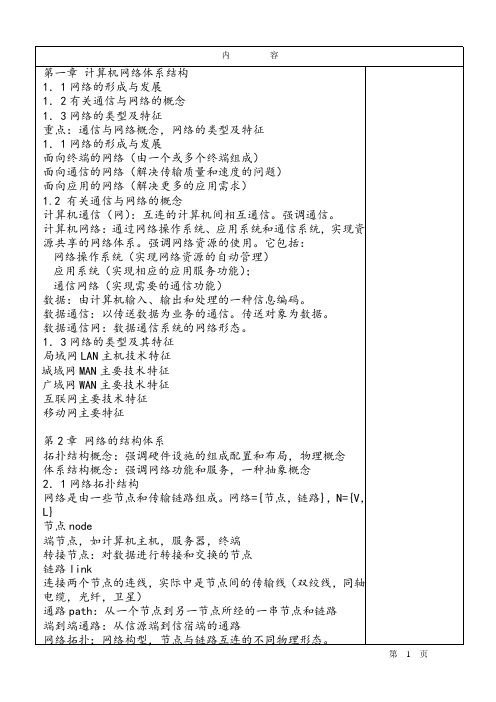
第一章计算机网络体系结构1.1网络的形成与发展1.2有关通信与网络的概念1.3网络的类型及特征重点:通信与网络概念,网络的类型及特征1.1网络的形成与发展面向终端的网络(由一个或多个终端组成)面向通信的网络(解决传输质量和速度的问题)面向应用的网络(解决更多的应用需求)1.2 有关通信与网络的概念计算机通信(网):互连的计算机间相互通信。
强调通信。
计算机网络:通过网络操作系统、应用系统和通信系统,实现资源共享的网络体系。
强调网络资源的使用。
它包括:网络操作系统(实现网络资源的自动管理)应用系统(实现相应的应用服务功能);通信网络(实现需要的通信功能)数据:由计算机输入、输出和处理的一种信息编码。
数据通信:以传送数据为业务的通信。
传送对象为数据。
数据通信网:数据通信系统的网络形态。
1.3网络的类型及其特征局域网LAN主机技术特征城域网MAN主要技术特征广域网WAN主要技术特征互联网主要技术特征移动网主要特征第2章网络的结构体系拓扑结构概念:强调硬件设施的组成配置和布局,物理概念体系结构概念:强调网络功能和服务,一种抽象概念2.1网络拓扑结构网络是由一些节点和传输链路组成。
网络={节点,链路},N={V,L}节点node端节点,如计算机主机,服务器,终端转接节点:对数据进行转接和交换的节点链路link连接两个节点的连线,实际中是节点间的传输线(双绞线,同轴电缆,光纤,卫星)通路path:从一个节点到另一节点所经的一串节点和链路端到端通路:从信源端到信宿端的通路网络拓扑:网络构型,节点与链路互连的不同物理形态。
总线型:节点挂接在一条公共总线上,广播且受限于总线带宽星型和树型:有一个中心转接节点,受限于中心节点环型网络:若干段链路组成环,共公环内数据单向流动,串行通过每个环接口部件网型网络:任一节点一般都有两条以上的链路,没有一个中心,流向不定1.用户子网,作用:提供网络资源。
又称为资源子网,由资源节点和本地的转接点构成本地网2.通信子网(主干网,骨干网)作用:为用户子网提供传输和交换数据的服务组成:转接节点(节点交换机SW)+传输链路(介质和信道)+通信软件+状态监控故障诊断错误报告2.2网络体系结构网络体系结构:对网络体系功能的一种逻辑结构描述。
计算机网络与通信的知识点总结

计算机网络与通信的知识点总结计算机网络与通信是现代信息技术的基础,它涉及到了许多重要的概念和技术。
本文将对计算机网络与通信的一些重要知识点进行总结,帮助读者更好地理解和应用这些概念。
一、计算机网络的基本概念1. 计算机网络的定义:计算机网络是指将分布在不同地理位置的计算机和其他设备通过通信线路互连起来,实现信息交换和资源共享的系统。
2. 网络拓扑结构:常见的网络拓扑结构包括总线型、环型、星型、树型和网状型等,每种结构都有其特点和适用场景。
3. 网络协议:网络协议是计算机网络中实现通信的规则和约定。
常见的网络协议有TCP/IP协议、HTTP协议、FTP协议等。
二、计算机网络的层次结构1. OSI参考模型:OSI参考模型是一种将计算机网络分为七层的抽象模型,包括物理层、数据链路层、网络层、传输层、会话层、表示层和应用层。
每一层都有不同的功能和责任。
2. TCP/IP模型:TCP/IP模型是实际应用最广泛的网络层次结构,它包括物理层、数据链路层、网络层、传输层和应用层。
三、网络通信的基本原理1. 数据传输方式:常见的数据传输方式有单工、半双工和全双工。
单工只能单向传输数据,半双工可以双向传输但不能同时进行,全双工可以同时进行双向传输。
2. 数据交换方式:数据交换方式包括电路交换、报文交换和分组交换。
电路交换在通信开始前需要建立一条专用的物理连接,报文交换将数据分成固定长度的报文进行传输,分组交换将数据分成较小的数据包进行传输。
3. 数据传输的可靠性:为了保证数据传输的可靠性,常用的方法有检错、重传和流量控制等。
四、常见的网络协议和技术1. IP协议:IP协议是互联网上最常用的网络协议之一,它负责将数据包从源主机传输到目标主机。
2. TCP协议:TCP协议是一种可靠的传输协议,它负责将数据分割成报文段,并通过网络将其传输到目标主机,然后再将其重新组装成完整的数据。
3. HTTP协议:HTTP协议是一种应用层协议,它定义了Web浏览器和Web服务器之间的通信规则,常用于传输超文本和其他资源。
《计算机网络与通信》PPT课件

7
DTE与DCE
在物理层,实体间的物理数据单元的传输是在相邻的通信 设备上进行的。通信设备分为DTE 和DCE两类: • 数据终端设备DTE (Data Terminal Equipment)是具有一 定数据处理能力和具有发送、接收数据能力的设备。 • 数据电路端接设备DCE (Data Circuit terminating Equip ment)在DTE与传输介质之间提供信号变换和编码功能,并 负责建立、维护和释放物理连接。
• EIA/TIA为UTP 制定了包括5个类的布线标准:
• 1类线:用于电话传输; • 2类线:含4对双绞线,可用于电话传输和最高为4Mbps
的数据传输; • 3类线:含4对双绞线,可用于最高为10Mbps的数据传输
,适用于10 Base T网络; • 4类线:含4对双绞线,可用于最高为16Mbps的数据传输
。 • 位同步:收发双方的时钟同步。 • 线路配置:点到点连接或多点连接。 • 物理拓扑:物理设备之间的连接形式。 • 通信方式:单工通信、半双工通信和全双工通信。
10
物理层的概念
3.1.2 物理层协议
• 物理层从四个方面对物理设备和传输之间的接口进行 定义。
1. 机械特性: •定义接口部件的形状、尺寸、引脚数目 和排列方式、接插件的锁紧方式等。
3
3.1 物理层基本概念
3.1.1 基本概念
1.物理层定义
• 物理层为建立、维护和释放数据链路实体之间二进制 比特传输的物理链路提供机械的、电气的、功能的和 过程的特性。
• 物理链路的连接可以通过中继系统,允许进行全双工 或半双工的二进制比特流的传输。
计算机网络与通信工程培训资料
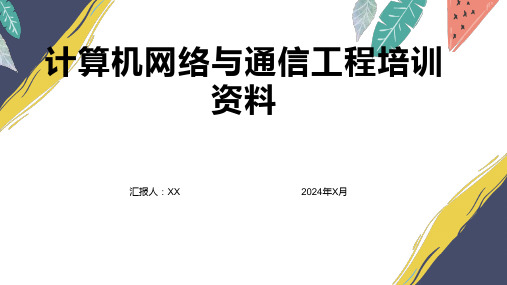
通信工程安全与管理
01 弱点分析
评估网络存在的弱点
02 网络管理实践
实际应用管理策略
03 安全策略制定
制定网络安全方针
● 06
第六章 总结与展望
学习回顾与展望
总结计算机网络与 通信工程知识
深入了解网络协议 掌握通信原理 熟悉网络安全 了解网络拓扑结构
未来通信技术发展 趋势
5G网络的普及 物联网技术的发展 人工智能在通信中的应用 量子通信的研究
以太网技术
以太网帧结构
目的MAC地址 源MAC地址 类型/长度字段 数据字段
交换机和网桥
作用 区别 工作原理
VLAN和QoS技术
应用场景 技术原理 优缺点
网络路由技术
静态路由是手动配置路由表,适用于小型网络; 动态路由根据网络状况自动更新路由表,适用于 大型网络。路由器根据转发表选择最佳路径进行 数据转发,路由选择算法包括距离矢量算法和链 路状态算法。OSPF协议适用于单一自治系统内 部,BGP协议用于不同自治系统之间的路由互联。
计算机网络与通信工程培训 资料
汇报人:XX
2024年X月
第1章 简介 第2章 网络协议与技术 第3章 网络设备与配置 第4章 网络性能与优化 第5章 通信工程实践与案例 第6章 总结与展望
目录
● 01
第1章 简介
计算机网络与通 信工程概述
计算机网络是指利用 通信设备与线路互相 连接起来,传输数据 信息的系统。通信工 程则是应用通信技术 进行信息传递和交流 的学科领域。本课程 将介绍计算机网络与 通信工程的基本概念、 发展历史以及应用领 域。
网络容量规 划
确定网络各部分 的容量需求
性能预测
预测网络的性能 表现
《计算机网络与通信》PPT课件

本章主要介绍数据通信的基本概 念、数据传输技术、多路复用技 术、数据交换技术及差错控制技 术
编辑ppt
1
2.1 数据通信的基本概念
数据通信系统的基本组成 数据通信的几个基本概念 模拟传输和数字传输 数据通信系统的质量指标
编辑ppt
2
2.1.1 数据通信系统的基本组成
1、通信系统的基本模型
5
2.1.2 数据通信的几个基本概念
1、信号频带及频谱分析 (2)周期性非正弦信号的傅氏级数及频谱特性
现在给出一个数学描述。假设s(t)是一个周期为P的周期函数。 依据傅立叶变换的其中一种形式:
s(t)a 2 0i 1[a i co 2 P is)t (b i si2 n P i)t(]
编辑ppt
8
2.1.2
我们来看一个列子,令s(t)为:
s(t) 1 1
0t;2t3;4t5;... t2;3t4;5t6;...
这是一个周期为2π的方波。
s(t)
1
t
2 3 4 5 6 7
8
-1
编辑ppt
9
2.4.2 模拟信号
1. 傅立叶变换
因为它是一个周期函数(周期为2),所以可以把它写成一个傅立叶级数。 在这里,所有的常量ai(i≥0 )都为0。常量bi定义为
6
2.1.2 数据通信的几个基本概念
1、信号频带及频谱分析 (2)周期性非正弦信号的傅氏级数及频谱特性
(还有其他的形式,但这种更适合我们这里的需要。)
其中的系数ai和bi被定义为:
ai
2 P/2s(t)cos2(it)dt
P P/2
P
bi
P/2
2 s(t)si P
计算机网络与通信5PPT课件
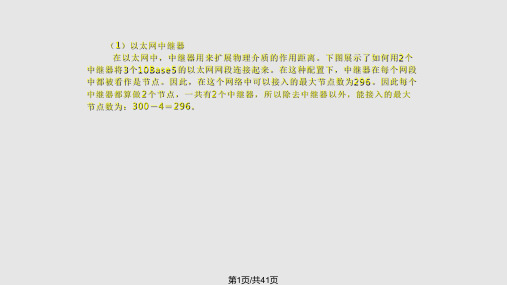
5.7 Gateway(网关)
网关是指在信息流过使用不同协议的网络时翻译数据的设备,也称为协议转 换器,是最复杂的网络互连设备,通常工作在OSI七层模型的第三层和更高层。网 关的互连模型如图所示。
第32页/共41页
网络系统的需求和规划
5.8 校园网系统集成实例
一、设计原则
(1) 开放式系统 (2) 标准化 (3) 网络化
(4) 交换机主要是用来连接网络中的各个网段;路由器则可以通过端到端的 路由选择来连接不同的网络,并可实现与Internet的接入。
第30页/共41页
5.6 3层交换机
第三层交换机基本概念 三层交换机的功能
(1) 分组转发 (2) 路由处理 (3) 安全服务 (4) 特殊服务 3层交换机之所以较路由器交换速度快,主要是3层交换机提供的功能相对较少,牺 牲其灵活、易控和安全性能来提高速度。对于那些更需要速度而不是可管理性和安全性的 网络来说3层交换机是最理想的选择,反之路由器是最佳选择。
一是一是hubhub只是一个多端口的信号放大设备工作中当一个端口接收到数据信只是一个多端口的信号放大设备工作中当一个端口接收到数据信号时由于信号在从源端口到号时由于信号在从源端口到hubhub的传输过程中已有了衰减所以的传输过程中已有了衰减所以hubhub便将该信便将该信号进行整形放大使被衰减的信号再生号进行整形放大使被衰减的信号再生恢复恢复到发送时的状态紧接着转发到其他到发送时的状态紧接着转发到其他所有处于工作状态的端口上
第26页/共41页
路由器的分类 (1) 按处理能力来划分 从处理能力可将路由器分为高端路由器和中低端路由器。通常将背板交换能力
大于40Gb/s以上的路由器称为高端路由器,背板交换能力在40Gb/s以下的路由 器称为中低端路由器。
计算机网络与通信基础 课件
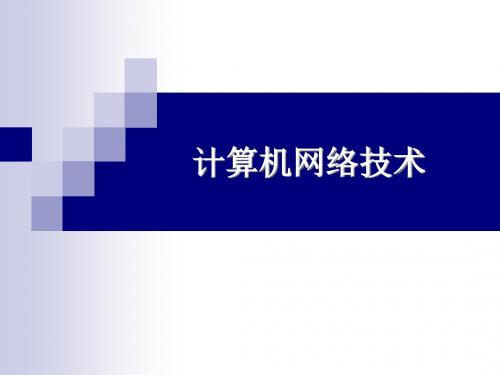
二、数据通信中的主要技术指标
Shannon公式:用于有噪声干扰信道
C: 传输率,单位b/s
C = B log2 (1+S/N)
B: 带宽,单位Hz
S: 信道中信号功率 N:信道中电磁噪声
功率
例:信道带宽W=3.1kHz,S/N=2000,则 C = 3100×log2(1+2000)≈ 34kb/s 即该信道上的最大数据传输率不会大于34kb/s。
非理想信道
实际的信道上存在损耗、延迟、噪声。
信号:
传输数据:
0
1
0
1
1
0
0
1
1
0
0
1
0
1
0
损耗引起信号强度减弱,导致信噪比S/N降低。 延迟会使接收端的信号产生畸变。 噪声会破坏信号,产生误码。
噪声:
例如:数据传输速率为56kb/s时,持续时间0.01s的干扰会破坏约 560个比特。
第1章 计算机网络与通信基础
一、数据通信的基本概念
二、数据通信中的主要技术指标
三、通信方式
预习:要理解的问题
1、数据传输率、信道容量的概念 2、并行通信、串行通信(单,双,半双)
一、数据通信的基本概念
数据:对客观事实进行描述与记载的物理符 号,如数值、文字、声音、图形、图像和动 画等。
模拟数据:连续变化,如温度、压力。
一、数据通信的基本概念
比特率:
在数字信道中,比特率是数字信号的传输速率,它用单位时间内传输的 二进制代码的有效位(bit)数来表示,
其单位为每秒比特数bit/s(bps)、每秒千比特数(Kbps)或每秒兆比特数(Mbps) 来表示(此处K和M分别为1000和1000000,而不是涉及计算机存储器容量时 的1024和1048576)。
计算机通信与网络技术

一、通信的历史回顾
■ 1837 Samuel Morse 电报 • Morse Code
■ 1876 Alexander Graham Bell 电话 ■ 1945 ENIAC ■ 80年代 PC发展 ■ 9 0 年 代 Internet
应用
■ 电话 ■ 卫星电视 ■ 广播
■ LAN WAN 通信
■ Email ■ Teleconferencing ■ Cellular Telephone ■ Information Service
焦点问题
■ 什么是连接?
• 导线? 电缆? 光纤?
■ 通信标准
■ 易用性
■ 安全性
■ 开放性
二、标准和标准化组织
■ 由于各种计算机总是不尽相同 , 所以它们之间的数据传输要比--运输层
■ 运输层(Transport Layer )运输层负责选择通信使用的网络 。 • 一 台计算机可能连接着好几个网络 , 其速度、费用和通信类型各不相同 。到 底选择哪一个取决于很多因素 。 比如 , 传输的信息是很长的连续数据流 , 还 是分为多次间歇传送。 ■ 接收方不仅要对分组重新排序 , 还得验证所有的分组是否都已收到。
■ 不同国家人说话-----------翻译
不同机器间通信-----------协议
■ 网络标准化组织
网络标准化组织
■ 在建立网络标准以确保通信和网络 设备有 统一 的 标准方面 , 许多美国和国际组织发挥了重要的 作 • 美国国家标准化协会( A N S I )。 • 电气电子工程师协会( I E E E )。 • 国际通信联盟( I T U )。 • 国际标准化组织( I S O )。 • Internet 协会( I S O C )相关的I n t e r n e t 工程任务组( I E T
- 1、下载文档前请自行甄别文档内容的完整性,平台不提供额外的编辑、内容补充、找答案等附加服务。
- 2、"仅部分预览"的文档,不可在线预览部分如存在完整性等问题,可反馈申请退款(可完整预览的文档不适用该条件!)。
- 3、如文档侵犯您的权益,请联系客服反馈,我们会尽快为您处理(人工客服工作时间:9:00-18:30)。
CCN: Lecture Notes
Computer Comm. & Networking 3
Ring
• Reduces cabling costs • One node or line down and network dies • Cable rout must be circular
CCN: Lecture Notes
CCN: Lecture Notes
Computer Comm. & Networking 16
Broadband Systems (Cont’d)
Forward and reverse directions may be accomplished by different frequencies on a single cable or by using dual cables
CCN: Lecture Notes
Computer Comm. & Networking 11
Thin wire
• ≈ 0.25″ coaxial cable , i.e., RG58 • Less flexible • High data rates • Used as bus or ring cable • Used as drop* from network
CCN: Lecture Notes
Computer Comm. & Networking 7
A Typical Baseband System
Digital Information
Source
Format
Analog
Sampler
Information
Quantizer
Analog Information
CCN: Lecture Notes
Computer Comm. & Networking 13
Optical Fibre
• Rigid • Very high data r backbone
Wireless
• Infrared at 850 and 950nm • Spread spectrum modulated on 2.4 GHz ISM band • Mainly office networks, store inventory etc. • Generally moderate bit rates but portable
• Cable ends must be terminated
¾ Attach resistor across last node or loose cable end
• Tees must be avoided
¾ Problem when DTE is not close to cable
¾ Use a transceiver to connect onto the cable
4. Bandwidth Communication channels are usually band limited. One has to consider the bandwidth efficiency of the coding scheme.
5. Noise immunity Some schemes are more immune to noise than others.
Module 2
Computer Networking
A specific and very important application of data communications is computer networking. We need to examine what topologies and protocols a computer network may employ.
Computer Comm. & Networking 5
Hub/Tree
• Hub is bus/ring with all wiring inside one box • Cross between star and bus/ring • Can be combined into trees
CCN: Lecture Notes
CCN: Lecture Notes
Computer Comm. & Networking 10
Twisted wire
• Shielded and unshielded • Flexible, i.e., easy to install • Normally used for
• Low grade star networks • Hub-DTE connections • Network drop* • Low to medium data rates
Computer Comm. & Networking 4
Bus
• Further reduced cabling costs • Non circular rout • One node down, rest still work • Interconnected via bridges
CCN: Lecture Notes
CCN: Lecture Notes
Computer Comm. & Networking 12
Thick wire
• ≈ 0.5″ coaxial cable • Rigid, i.e., hard to run • High data rates • Used as bus, ring or backbone cable
¾ Receives and transmits signal onto cable directly
¾ Converts signal into a form suitable for drop cable and DTE connection (Ethernet card in PC)
¾ Transceivers and DTE connections may connect via same signals as main cable or via twisted pairs through an Attachment Unit Interface (AUI)
-V
+V
0
RZ-AMI
-V
+V
Bi-φ -L
-V
+V
Bi-φ -M
-V
+V
Bi-φ -S
-V
+V
-V
DM
Computer Comm. & Networking 9
When selecting a coding scheme, one should consider the following:
1. DC component System which requires AC coupling cannot use those schemes that contain DC component. E.g. Unipolar NRZ
Using a single cable
Headend amplifiers retransmit the received signal onto the transmit frequency or onto the transmit cable
CCN: Lecture Notes
Computer Comm. & Networking 17
Receiver
CCN: Lecture Notes
Computer Comm. & Networking 8
Baseband waveforms
CCN: Lecture Notes
1011000110
+V
-V
NRZ-L
+V
-V
NRZ-M
+V
-V
NRZ-S
+V
Unipolar RZ
0
+V
0
Bipolar RZ
• Star • Ring • Bus • Hub/Tree
CCN: Lecture Notes
Computer Comm. & Networking 2
Star
• Uses large amount of cable • Outage of node connection does not affect others
Computer Comm. & Networking 6
LAN-Media
Baseband systems
A baseband system sends digital signals straight to line. They may be encoded (e.g. Manchester code) but they are not modulated.
What is Baseband?
The original frequency band of the message signal, usually from (near) dc to a few megahertz.
Examples of Baseband transmission systems ⇒ LANS (ethernet, token ring) ⇒ RS232C ⇒ Magnetic discs and tapes
